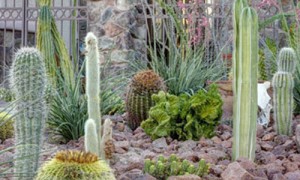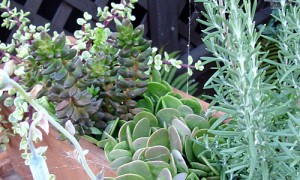One thing is certain in the desert: The summer can get hot — very hot — with triple-digit temperatures and little rain. This intense heat can take its toll on your home’s landscaping.
However, with careful planning, incorporating desert plants, and utilizing water-friendly landscaping techniques, your home’s yard can be a desert oasis year-round.
Planning and Design
Developing a plan with water conservation and xeriscape methods in mind is the first step in water-efficient landscaping.
1) Survey Your Yard.
- Start by evaluating your existing landscaping and decide what you would like changed.
- Draw your property to scale on graph paper and include existing structures, current irrigation, underground utility lines, as well as plants and trees that will remain.
- Note the areas of your property that are in full sun, partial sun, and shade.
- Ask yourself if you need an outdoor space that is child- or pet-friendly.
- Sketch out your vision and possible plant placement.
2) Understand the Rules.
- Find out if there are any municipal or community requirements before re-landscaping your yard.
- If you live in a homeowners’ association, review your CC&Rs to learn about any pre-approvals and/or approved plant lists that apply to the front yard or back yard.
Conserving Water
When developing your landscape design, consider these ways to reduce water use:
- Efficient Irrigation: Use automatic sprinklers and drip-irrigation systems with efficient emitters to help conserve water. Check the system frequently for leaks and water runoff. Programmable irrigation clocks help control water use and can be set according to local watering schedules and restrictions.
- Hydrozones: Group plants with similar watering needs to create irrigation “hydrozones.” By placing plants with similar watering needs together, watering schedules can be customized by zone, ensuring that each group receives just the right amount.
- Practical Turf Areas: The decision to incorporate grass into your landscape should be based on practicality and function. Will the grassy area actually be used, like in a child’s play area, or is it for aesthetic purposes? Drought-tolerant turf grasses are available, including Bermuda. Artificial grass is another option.
Choosing Desert Plants
After creating a generic landscape layout, it is time to select desert plants. Before heading to a nursery, ask yourself the following questions:
- What is the purpose of each plant? Will it be a focal point, in the backdrop, ground cover, shade producing, or food bearing?
- Do you want to attract birds, butterflies, or bees?
- What is the plant’s size at maturity?
- Do you want easy-to-maintain plants, or do you have a green thumb and enjoy a challenge?
With these answers, you can begin your plant search. Lists of desert plants specific to southern Nevada are available at local nurseries and online. The Southern Nevada Water Authority’s Water Smart Landscapes Program plant list, for example, provides useful information om hundreds of different landscaping plants.
Seeing Is Believing
Sometimes it is best to take a firsthand look at desert plants before choosing. In addition to nurseries, visit these desert gardens:
- Springs Preserve, 333 S. Valley View Blvd., Las Vegas, NV 89107, (702) 822-7700: 110 acres of display gardens, natural gardens, and wildlife habitats; landscaping and gardening classes; and a searchable online plant database
- Botanical Cactus Garden at Ethel M Chocolates, 2 Cactus Garden Drive, Henderson, NV 89014, (702) 435-2655: 4 acres of over 300 species of drought-tolerant ornamentals, cacti, and other succulents
[cf]skyword_tracking_tag[/cf]







[…] Preserve, 333 S. Valley View Blvd., Las Vegas, NV 89107, (702) 822-7700: 110 acres of …read more Are you buying or selling? Call me. Elouise Margita Coldwell Banker United This […]